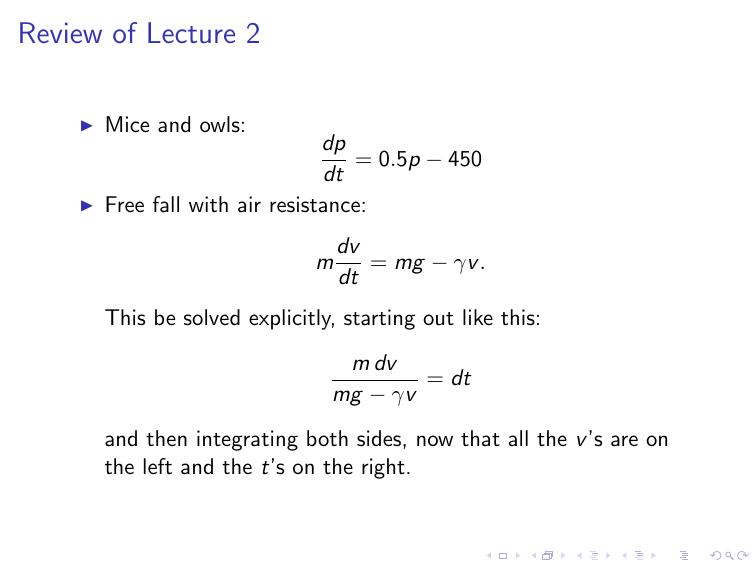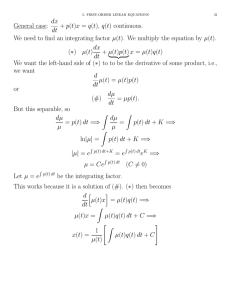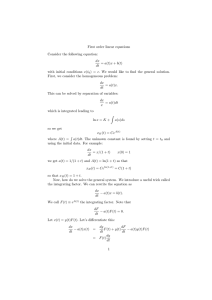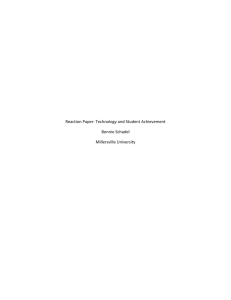Integrating Factors

Review of Lecture 2
I Mice and owls: dp
= 0 .
5 p − 450 dt
I Free fall with air resistance: m dv dt
= mg − γ v .
This be solved explicitly, starting out like this: m dv mg − γ v
= dt and then integrating both sides, now that all the v ’s are on the left and the t ’s on the right.
First order linear equations y
0
+ p ( t ) y = g ( t ) is the general first-order linear equation.
I This is the same as dy dt
+ p ( t ) y = g ( t )
I It can also be written y
0
+ py = g without explicitly mentioning the t -dependence of p and g .
I The examples we studied last time had p ( t ) and g ( t ) constant. Then you can separate the y and the t on two sides of the equation and integrate.
I That doesn’t work if p and g are not both constant.
Integrating Factors
You’ll need to know some Greek letters for this course–study up if you don’t know them. For example µ is “mu.”
To solve a first-order linear equation, the trick is to multiply both sides by a suitable “integrating factor” µ ( t ). We want the left side to become
( µ y )
0
From calculus recall
( µ y )
0
= µ y
0
+ µ
0 y
Compare that to
µ ( y
0
+ py )
They would match if µ
0
= µ p .
Integrating Factors
You’ll need to know some Greek letters for this course–study up if you don’t know them. For example µ is “mu.” To solve a first-order linear equation, the trick is to multiply both sides by a suitable “integrating factor” µ ( t ). We want the left side to become
( µ y )
0
From calculus recall
( µ y )
0
= µ y
0
+ µ
0 y
Compare that to
µ ( y
0
+ py )
They would match if µ
0
= µ p .
Integrating Factors
You’ll need to know some Greek letters for this course–study up if you don’t know them. For example µ is “mu.” To solve a first-order linear equation, the trick is to multiply both sides by a suitable “integrating factor” µ ( t ). We want the left side to become
( µ y )
0
From calculus recall
( µ y )
0
= µ y
0
+ µ
0 y
Compare that to
µ ( y
0
+ py )
They would match if µ
0
= µ p .
Integrating Factors
We want
µ ( y
0
+ py ) = µ y
0
+ µ
0 y = ( µ y )
0
.
That works if we take
µ = e
R t c p ( t ) dt since then
µ
0 d
= µ dt
= µ p
Z t c p ( t ) dt
It doesn’t matter what the lower limit c of integration is.
Integrating Factors
So the method is this:
I Identify that you have a first-order linear equation
I Calculate the integrating factor, e to the integral of the coefficient of y .
I Multiply both sides by it
I Regroup so the left side is a derivative
I Integrate
Now let’s practice this method
Four examples are worked in the textbook. Let’s take different ones. For example exercise 2, page 39 is y
0
− 2 y = t
2 e
2 t
Since the coefficient of y is − 2, its integral is − 2 t , so an integrating factor is
µ = e
− 2 t
Multiply both sides by µ . We know in advance the left side should be ( µ y )
0
:
( µ y )
0
= µ t
2 e
2 t
Let’s check directly:
µ ( y
0
− 2 y ) = µ y
0
− 2 y µ
= e
− 2 t y
0
− 2 ye
− 2 t
= µ y
0
= µ y
0
+ y d dt e
− 2 t
+ y µ
= ( µ y )
0
See, it worked.
Now let’s practice this method y
0
− 2 y = t
2 e
2 t
Since the coefficient of y is − 2, its integral is − 2 t , so an integrating factor is
µ = e
− 2 t
Multiply both sides by µ . We know in advance the left side should be ( µ y )
0
:
( µ y )
0
= µ t
2 e
2 t
Let’s check directly:
µ ( y
0
− 2 y ) = µ y
0
− 2 y µ
= e
− 2 t y
0
− 2 ye
− 2 t
= µ y
0
= µ y
0
+ y d dt e
− 2 t
+ y µ
= ( µ y )
0
See, it worked.
So we got
( µ y )
0
= µ t
2 e
2 t
Since this is a textbook problem the right side simplifies beautifully to t
2
. So
( µ y )
0
= t
2
µ y = e
− 2 t y =
Z t
2 dt = t
3
3
+ c y = e
2 t t
3
+ c
3
Behavior at infinity y = e
2 t t
3
3
+ c
When t is large, y goes to infinity.
Solution satisfying a given initial condition
Find the solution with y (0) = 0?
0 = e
0
(0 + c ) c = 0
1 y =
3 t
3 e
2 t
For the rest of the class period, we’ll work more examples and look at the graphs of some solutions.
Solution satisfying a given initial condition
Find the solution with y (0) = 0?
0 = e
0
(0 + c ) c = 0
1 y =
3 t
3 e
2 t
For the rest of the class period, we’ll work more examples and look at the graphs of some solutions.


